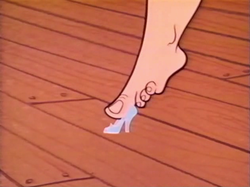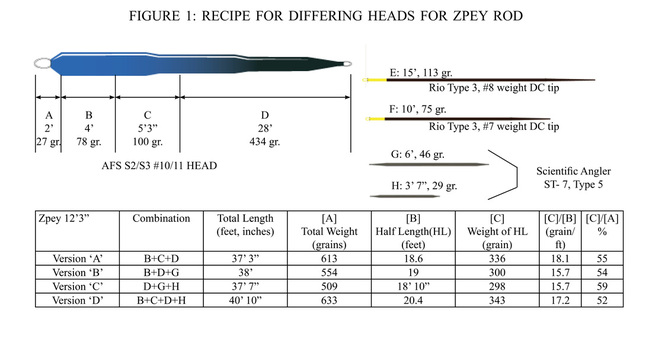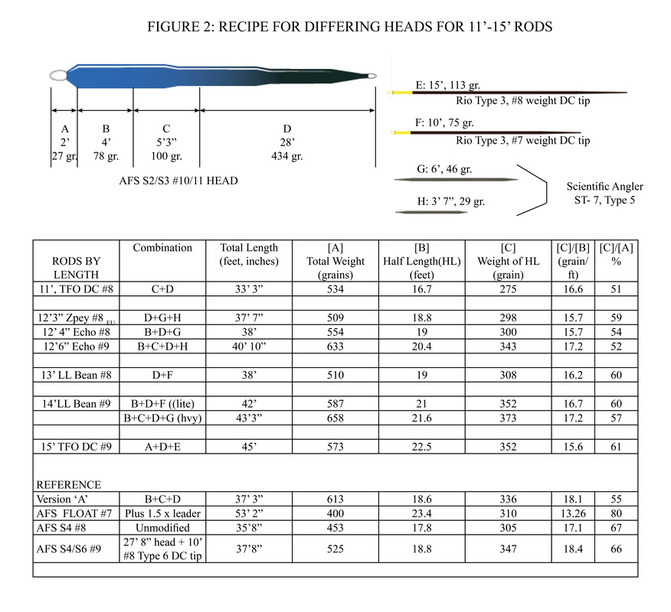
In the previous part 2 installment, TWO (2) hazards were discussed when trying to re-use the floating head line weight class for a sinking head. The Active-Line load appears to be a more telling story than the standardized effect of weight class. This part 3 installment is to explore what is behind Mystery door #3, an unpredictability we were left with from only having casted the unmodified final head in part 2. We will be chopping and assembling this unmodified head to get all 9 digits of the line matching zip code for that Zpey - or any other - rod. This is akin to getting both the right shoe length AND width size. At the end of this part 3, we will see behind door # 3 awaits some nice surprises, along with those that will make us ponder further depending on how far we want to go down the rabbit hole. Just as when we feel we are getting close to mastery, we are humbled when we simply end up as a better student.
Remember the saying that within a thick book is a thin book trying to come out? In this AFS Gen. 2 case, my discovery brought up that within a ONE (1) weight class for Scandi head are THREE (3) weight class trying to come out. And to boot, there is the added potential to obtain HALF (1/2) weight class in between whole numbers (not part of this installment's discussion). What you've got here is a highly tunable line loading system that can come in handy on days when one's casting timing has shifted from it's normal center. The only down side is your Scandi head will remind you of Frankenstein, with sections patched together with loop-to-loop connections. Hey, I too had the trepidation of playing chop-chop with oh-so-pristine-one-piece line, much like trying to tattoo your child's stomach. But for me - and perhaps you too - I soon discovered at the end something fulfilling and satisfying in customizing heads to my personal taste, creating many weight classes from one. And just as important, this discovery left me with more greenbacks in my wallet. Sorry kiddo about the tattoo.
Just like the fabled story of Jesus who had fed thousands with a handful of fish (bait fishermen, I cried), I eventually created my own combination chart centered around using ONE (1) head, capturing the many permutations for rods in my cache ranging from 11 to 15 feet, from rod classes #7 to #10. There is a lot to take in, but if we start with isolating the relationship between the THREE (3) heads for the Zpey rod, the rhyme and reasons that pervades in this chart will become self-evident.
Using Figure 1 below, let's start with the first Zpey head: the #10/11 AFS head as-is out-of-the-box (a restriction so as to make the line returnable as an option). As mentioned in part 2, I had used the #8/9 wt S4 head as my reference to what feels as a well-matched line/ rod combination. So, this # 8/9 weight reference pointed to using the S2S3 head as-is, although now shortened to 38' for cast-ability (footnote 3). This is known as Head A, with a total weight of 613 grains. The Active-Line loads for both the S4 reference and Head A calculate near identically to 347 and 336 grains respectively.
Just like the fabled story of Jesus who had fed thousands with a handful of fish (bait fishermen, I cried), I eventually created my own combination chart centered around using ONE (1) head, capturing the many permutations for rods in my cache ranging from 11 to 15 feet, from rod classes #7 to #10. There is a lot to take in, but if we start with isolating the relationship between the THREE (3) heads for the Zpey rod, the rhyme and reasons that pervades in this chart will become self-evident.
Using Figure 1 below, let's start with the first Zpey head: the #10/11 AFS head as-is out-of-the-box (a restriction so as to make the line returnable as an option). As mentioned in part 2, I had used the #8/9 wt S4 head as my reference to what feels as a well-matched line/ rod combination. So, this # 8/9 weight reference pointed to using the S2S3 head as-is, although now shortened to 38' for cast-ability (footnote 3). This is known as Head A, with a total weight of 613 grains. The Active-Line loads for both the S4 reference and Head A calculate near identically to 347 and 336 grains respectively.
But as I became a better caster, I found Head A to be too heavy, not releasing the rod tip early enough for maximum line energy. I soon developed a greater affinity for the lighter #7/8 S4 head as a better reference to my improved casting style. After having performed a many-mental-line-cutting in my head, I emerge from under this near Ph.D. calculation marathon with Head B of 38', 554 grain. Both the lighter Head B and its respective S4 reference now have a near identical Active-Line load of 300 grain and 305 grain respectively, a shedding of about 40 grains for the same section in Head A.
Again, as if my casting evolution had a life of its own, I found that there was possibly a much finer tuned head that would make the same jump as if switching from an AM station to its FM equivalent. By now, my son had ran away from home after seeing me once again comatose with more foreboding mental calculations, fleeing before I woke up to find my hand unconsciously curled as if holding a tattoo pen all the while. Head C comes out - after I explained myself well enough to Social Services - a much lighter overall head by almost 50 grain than Head B. Even though the Active-Line load for both Heads B and C are almost identical - suggesting an equal load resistance - Head C now cast with a much quicker rod tip release than B, maximizing the line speed even more. And by this, this suggest to me that the weight of the Non-Active line (section C to E in Figure 1, part 2 installment) has an effect on the overall line/ rod matching.
So, now that I have a well-suited Head C for the Zpey rod (effectively a #7 US class rod), I found that the heavier Head B loads (and releases) a #8 class rod well, whilst the even heavier Head D (a variant of Head A but with identical Active Line load) works equally well with a #9 class rod (footnote 1). I now have THREE (3) weight class heads from ONE (1) head.
While the Active-Line load alone simply loads the rod, it alone does not tell the story of how the Non-Active line portion eagerly allows the rod tip to recover that maximizes lines speed. This translates to either a clean and light rod tip recovery or a sluggish and heavy one; the former being the preference for Scandi casting, the latter coming closer to a Skagit cast. The neat thing about this is the separation between the two feels was made pronounced with a simple line tweak- the shedding of 50 grains in the Non-Active Line portion (footnote 2).
Using matching in BOTH 1) Active- Line load, and 2) Non-Active-Line release, Figure 2 below shows my array of chopped sections of the S2S3 head in conjunction with tips/ polyleaders to match the different rod lengths and weights classes in my cache (footnote 3). If you could follow the local example in Figure 1 for the Zpey and Echo rods easily, you will not only be able to understand this expanded table for the expanded group of rods, but perhaps you can see a combination I have missed (I can almost hear 'Wheeeeeeee' as you pass me by with your newly activated acumen).
Again, as if my casting evolution had a life of its own, I found that there was possibly a much finer tuned head that would make the same jump as if switching from an AM station to its FM equivalent. By now, my son had ran away from home after seeing me once again comatose with more foreboding mental calculations, fleeing before I woke up to find my hand unconsciously curled as if holding a tattoo pen all the while. Head C comes out - after I explained myself well enough to Social Services - a much lighter overall head by almost 50 grain than Head B. Even though the Active-Line load for both Heads B and C are almost identical - suggesting an equal load resistance - Head C now cast with a much quicker rod tip release than B, maximizing the line speed even more. And by this, this suggest to me that the weight of the Non-Active line (section C to E in Figure 1, part 2 installment) has an effect on the overall line/ rod matching.
So, now that I have a well-suited Head C for the Zpey rod (effectively a #7 US class rod), I found that the heavier Head B loads (and releases) a #8 class rod well, whilst the even heavier Head D (a variant of Head A but with identical Active Line load) works equally well with a #9 class rod (footnote 1). I now have THREE (3) weight class heads from ONE (1) head.
While the Active-Line load alone simply loads the rod, it alone does not tell the story of how the Non-Active line portion eagerly allows the rod tip to recover that maximizes lines speed. This translates to either a clean and light rod tip recovery or a sluggish and heavy one; the former being the preference for Scandi casting, the latter coming closer to a Skagit cast. The neat thing about this is the separation between the two feels was made pronounced with a simple line tweak- the shedding of 50 grains in the Non-Active Line portion (footnote 2).
Using matching in BOTH 1) Active- Line load, and 2) Non-Active-Line release, Figure 2 below shows my array of chopped sections of the S2S3 head in conjunction with tips/ polyleaders to match the different rod lengths and weights classes in my cache (footnote 3). If you could follow the local example in Figure 1 for the Zpey and Echo rods easily, you will not only be able to understand this expanded table for the expanded group of rods, but perhaps you can see a combination I have missed (I can almost hear 'Wheeeeeeee' as you pass me by with your newly activated acumen).
And with this, I hope this series not only decodes AFS and the hidden realities masked by the weight class designation, but the explorer within you is now awakened so that when its foot hits the floor, the Satan of status quo thinking won't have a choice but to say 'Oh crap, he's up'. And this is how we overcome the common fault of trying to fit the dynamics of reality into the rules of language and numbers that simply causes a greater separation from - rather than an enjoining with - reality.
Footnote:
1) In order to do apples to apples comparison, Echo #8 and #9 weight Scandi rods were used as they are almost identical in length to the Zpey rod (measuring 12'4" and 12'6" respectively. Reference: 12'3" for Zpey rod).
2) The opposite is true for the heavier class weight #9, when compared to Head A, Head D has a more sluggish release, having 7 more grains for Active-Line load, but more importantly, 13 grains more in the Non-Active-Line load. This makes the D load more than A as the result of these two increases. The extra length is for a slightly longer #9 rod that requires a slightly longer anchor for more distance.
3) To be used with the recommended max Scandi head length in my previous blog (my on-stream experiments leads me to 3 times rod length for S2S3 max length).
Footnote:
1) In order to do apples to apples comparison, Echo #8 and #9 weight Scandi rods were used as they are almost identical in length to the Zpey rod (measuring 12'4" and 12'6" respectively. Reference: 12'3" for Zpey rod).
2) The opposite is true for the heavier class weight #9, when compared to Head A, Head D has a more sluggish release, having 7 more grains for Active-Line load, but more importantly, 13 grains more in the Non-Active-Line load. This makes the D load more than A as the result of these two increases. The extra length is for a slightly longer #9 rod that requires a slightly longer anchor for more distance.
3) To be used with the recommended max Scandi head length in my previous blog (my on-stream experiments leads me to 3 times rod length for S2S3 max length).


 RSS Feed
RSS Feed
